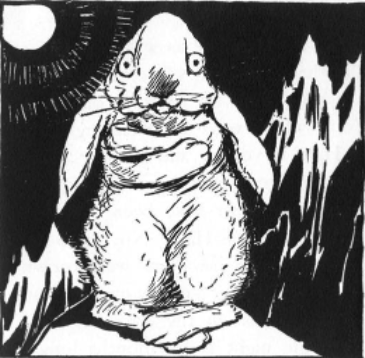An Arctic Hare
By Oliver Herford
Annotations by Karen Kilcup

An Arc-tic Hare we now be-hold. The hair, you will ob-serve, is white;[1] But if you think the Hare is old, You will be ver-y far from right. The Hare is young, and yet the hair Grew white in but a sin-gle night. When, then it must have been a scare That turned this Hare. No; ’twas not fright (Al-though such cases are well known); I fear that once a-gain you’re wrong. Know then, that in the Arc-tic Zone A sin-gle night is six months long.[2]
Herford, Oliver. “An Arctic Hare.” A Child’s Primer of Natural History. New York: Charles Scribner’s Sons, 1899.
[1] Arctic hares live in Alaska, northern Canada, and parts of Greenland. They have large rear feet like snowshoes, and their coats turn white in the winter to help them evade predators. Those animals that live in the northernmost part of the species’ range remain white all year.
[2] In the Arctic the sun disappears beneath the horizon for several months, but most places in the zone have a twilight that lasts for many hours. See Rao in Resources.
Contexts
When Herford published his book, natural history was an obsessive subject for children’s writers. Popular magazines like St. Nicholas led the way, creating study groups like the St. Nicholas League and advocacy for bird protection through its Bird Defenders. Exotic or unfamiliar animals seemed to particularly fascinate American children. Contributors to St. Nick included prominent scientists like William T. Hornaday, who became the director of the New York Zoological Park (commonly known as the Bronx Zoo), and who founded the National Zoo in Washington, DC; famous naturalist John Burroughs; and Ernest Thompson Seton, founder of the Boy Scouts of America.
Herford’s poems, as well as their accompanying images, presented more fanciful accounts of animals but sometimes offered short natural history lessons. In this case, Herford foregrounds the hares’ native habitat, with its very short winter nights (although he exaggerates the duration of darkness). All the poems in this book hyphenate some words, presumably to instruct children—and their parents—how to read.
Resources for Further Study
- “Animal Facts: Arctic Hare.” Canadian Geographic, June 6, 2019.
- “Arctic Hare—Lepus arcticus.” Nature Works, NH PBS.
- Rao, Joe. “The Myth of Arctic Daylight and Darkness Exposed.” LiveScience, September 21, 2010. An astronomer unpacks the myth.
Contemporary Connections
The video “Arctic Hare” (by Wildlife All About) shows the hares in their natural habitat and gives information about the animals’ characteristics, behaviors, and challenges.
The WWF (World Wildlife Fund) has a symbolic adoption program that helps raise funds to protect the arctic hare.